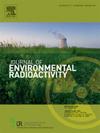Spatial variability in residence time of Beryllium in the Indian Ocean
IF 1.9
3区 环境科学与生态学
Q3 ENVIRONMENTAL SCIENCES
引用次数: 0
Abstract
Residence time of an element in the ocean is a consequence of its chemical behaviour and the various biogeochemical processes governing its distribution, sources, and sinks. Precise estimation of the residence time of beryllium(Be) is necessary for its application as a tracer for understanding present and paleo-environmental processes. We utilise cosmogenic 10Be and terrestrially derived 9Be measurements from surface sediments to estimate the residence time of Be in the Indian Ocean. Significant variation in Be residence time is observed, which ranges between 370 and 620 years in the central Indian Ocean, 64–205 years in the Bay of Bengal, 41–117 years in the Andaman Sea, and 179–443 years in the Arabian Sea. Large heterogeneity in the residence time of Be can be attributed to its variable scavenging efficiency in different regions. Active scavenging of Be by sediment particles contributed through various major rivers draining into the northern Indian Ocean results in short residence time of Be. The results of this study have significant implications for the selection of sample sites and the use of Be as a tracer in paleo reconstructions.
铍在印度洋停留时间的空间变化。
一种元素在海洋中的停留时间是其化学性质以及影响其分布、来源和吸收汇的各种生物地球化学过程的结果。要将铍作为示踪剂用于了解当前和古环境过程,就必须精确估算铍的停留时间。我们利用表层沉积物中的宇宙生成 10Be 和陆地衍生 9Be 测量数据来估算铍在印度洋的停留时间。我们观察到铍在印度洋中部的停留时间在 370-620 年之间,在孟加拉湾为 64-205 年,在安达曼海为 41-117 年,在阿拉伯海为 179-443 年。铍在不同区域的停留时间差异很大,这可能是由于铍在不同区域的清除效率不同。流入北印度洋的各条主要河流的沉积物颗粒对铍的积极清除作用导致铍的停留时间较短。这项研究的结果对于选择取样地点和在古重建中使用铍作为示踪剂具有重要意义。
本文章由计算机程序翻译,如有差异,请以英文原文为准。
求助全文
约1分钟内获得全文
求助全文
来源期刊

Journal of environmental radioactivity
环境科学-环境科学
CiteScore
4.70
自引率
13.00%
发文量
209
审稿时长
73 days
期刊介绍:
The Journal of Environmental Radioactivity provides a coherent international forum for publication of original research or review papers on any aspect of the occurrence of radioactivity in natural systems.
Relevant subject areas range from applications of environmental radionuclides as mechanistic or timescale tracers of natural processes to assessments of the radioecological or radiological effects of ambient radioactivity. Papers deal with naturally occurring nuclides or with those created and released by man through nuclear weapons manufacture and testing, energy production, fuel-cycle technology, etc. Reports on radioactivity in the oceans, sediments, rivers, lakes, groundwaters, soils, atmosphere and all divisions of the biosphere are welcomed, but these should not simply be of a monitoring nature unless the data are particularly innovative.
 求助内容:
求助内容: 应助结果提醒方式:
应助结果提醒方式:


